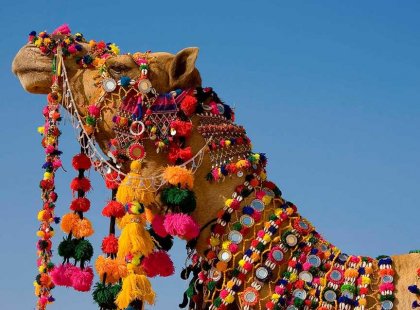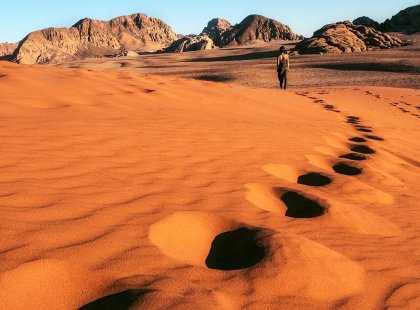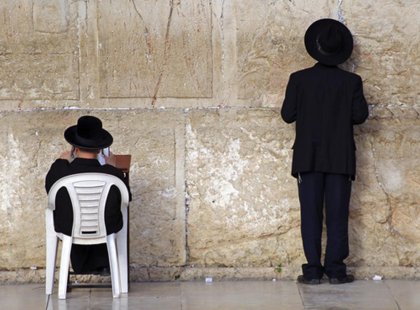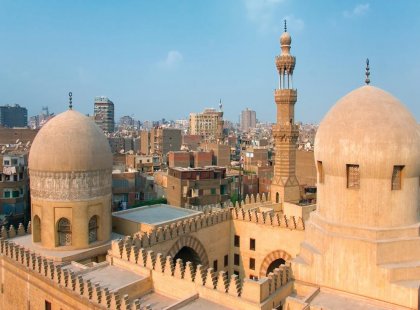Travel the Middle East across Egypt, Jordan, Israel, Palestine from Petra to the Dead Sea. Egypt, Jordan, Israel & Palestine are ancient lands that conjure images of river valleys, powerful Pharaohs, pilgrims and cities carved from stone. Dive headfirst into Cairo, sail up the Nile on a felucca, party in Tel Aviv, take a jeep safari across Wadi Rum and experience more World Heritage Sites than you can shake a stick at: Battir; Petra; the Old Cities of Cairo, Acre and Jerusalem; the Church of the Nativity… it goes on – and so will you as you trek, swim, explore, photograph and taste your way across the best of the Middle East. This adventure will leave you with a greater appreciation for life here and a hands-on experience of some of the most significant religious and human history in this part of the world. Before booking on this trip we recommend that you read the ‘Safety’ section in the trip notes regarding special safety considerations for Egypt trips.
-
Duration: 22 daysService level: Standard
-
Starts in: CairoPhysical Grading: Average
-
Ends in: Tel SusitaAges: 15+
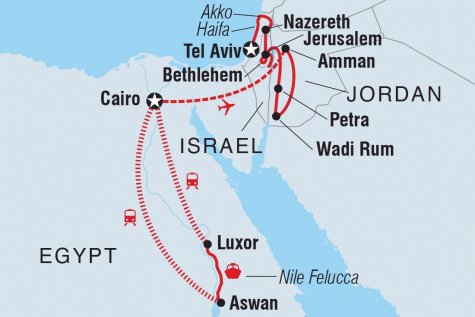
Itinerary
Start place: Cairo
If you arrive early in Cairo, perhaps travel along the river by felucca (a traditional wooden boat with broad canvas sails) or head out to explore the markets. If you want to escape the hustle and bustle, the Christian Coptic sector is well worth a visit.
Afterwards, make your way to the Egyptian Museum, home to one of the world's great collections of antiquities. Wander the treasure-filled halls of the museum, and make sure to check out the Mummies Hall (optional) for a close encounter with some of the country’s most important queens and pharaohs. Later in the evening, meet your leader and travel to Giza station, where you will board a sleeper train to Aswan (approximately 13 hours). Bedding and air-conditioning are provided.
Notes: Western-style toilets are located in each carriage, but we recommend bringing additional toilet paper. Keep in mind general train cleanliness may not be to the same standards you are accustomed to. An included dinner and breakfast are served on board. You may want to purchase something extra beforehand to supplement your meal, particularly if you're a vegetarian as only a single type of meal is served for dinner, which always includes meat. In rare circumstances you may be paired in your cabin with a group member of the opposite sex, depending on the group configuration. On other occasions, you might be sharing with another traveller of the same sex who may not be part of our group, again determined by the group configuration.
Today is a free day so take the opportunity to see such Aswan sites as the unfinished obelisk or the High Dam. The Nubian Bazaar is a must, while the excellent Nubian Museum is top of many visitors’ lists. Highly recommended is the beautiful Temple of Isis (the Goddess of health, marriage and wisdom) that was rescued from the rising waters of the Nile and relocated on Philae Island. It's a marvel of decorative pylons featuring some of Egypt's finest carvings – definitely one of the real gems of Upper Egypt. The evening sound and light show at Philae Temple is a beautiful experience – well worth the 100 Egyptian pounds. The waterfront promenade, or Aswan's 'corniche', runs alongside one of Nile's most appealing stretches and is the perfect place to stop for a mint tea.
This evening you’ll experience modern Nubian culture first-hand with a visit to a nearby village. You’ll join a local Nubian family for dinner and get an unforgettable insight into the daily life of the local people. This is a rare and memorable experience, giving you the chance to become fully immersed in the local culture.
Otherwise, you could take a sailboat ride around the islands in a traditional felucca, stopping off at the botanical gardens on Kitchener's Island. Alternatively, take a camel ride to the Monastery of St Simeon, an abandoned 7th-century fortress monastery located in the desert on the Nile's west bank. Your tour leader will be on hand to help you arrange any excursions. Alternatively, you may prefer to simply relax and take in the beauty of the Nile, or do some shopping in the friendly bazaar.
Notes: Flights can be booked online through EgyptAir: http://www.egyptair.com/English Return flights vary throughout the season, depending on the day of the week you fly and how far in advance you book, but expect to pay between US$250-300. Due to the southerly location, it's recommended to book the early flight and visit Abu Simbel at sunrise to avoid the heat.
Notes: Conditions will be basic during your felucca trip. If you are prepared for this, you’re sure to have a memorable adventure. You'll sleep outside on the deck of the felucca on a mattress. While blankets are provided, a sleeping sheet or sleeping bag is recommended. During the colder months (October to March) temperatures can get as low as 5°C at night. Slight alterations may have to be made to the Nile itinerary throughout the year, depending on winds and currents. As the felucca is a sailing craft without any outboard engine, if there's no wind we won't travel very far. Our Felucca does have a shared bathroom facilitiy onboard.
From the spectacular temple complex of Karnak to the Valley of the Kings, Luxor is full of wonderfully preserved reminders of the Pharaohs.
On the way, there's the option to visit either the unique mirror-image design of the Temple of Kom Ombo, or the beautifully preserved Temple of Edfu, also dedicated to Horus, the falcon-headed god.
Today you’ll visit the Intrepid Foundation's local project ACE (Animal Care in Egypt). It’s a great chance to see the holistic approach the project takes towards animal welfare, and to raising awareness among the locals.
You’ll also explore the magnificent Karnak Temple, which is perhaps the most impressive of all the ancient Pharoahs' monumental works. One of the world's most celebrated temple complexes, Karnak is a house of the gods built over a period of some 200 years. Your guided tour of this vast temple of impressive pylons, obelisks and chapels will reveal its finest sections, such as the Avenue of Sphinxes and the Great Temple of Amun.
The rest of the day will be free to relax, shop in the bazaar (open until quite late) or perhaps experience the atmosphere of a local teahouse.
Continue on to the spectacular royal burial site of the Valley of the Kings. Buried under the arid hills here are over 60 richly decorated tombs of pharaohs. With your leader, explore this sprawling and spectacular place, where the pharaohs of the New Kingdom (16th to 11th century BC) were secretly interred for all eternity, and where discoveries are still being made. Your group leader will explain the history and legends of these remarkable people, their funerary rites, and the significance of the many paintings and hieroglyphics.
Join a local family for lunch to try some tasty traditional home cooking.
The rest of your afternoon is free to explore. The Luxor Museum is a great place to visit in your free time. Alternatively, hire a bicycle and venture into the countryside. For a more upscale experience, check out the Winter Palace, a lovely five-star historical building with wonderful views over the Nile – a great place for a refreshing cocktail.
Catch an overnight sleeper train from Luxor to Cairo (approximately 10 hours).
Notes: A mattress and blankets are provided. Please be aware that while the desert may be very hot during the day, it will still be cool at night and warm clothes and a sleeping bag are highly recommended when travelling outside of the summer months. Western-style toilet facilities are available, solar panel showers are available.
Notes: Please make sure you have appropriate, sturdy, comfortable footwear for this trek.
After a full day of exploring, maybe gather your travel buddies together and share a celebratory shisha as this Jordan exploration comes to an end.
That afternoon, get another perspective on modern day life in Jerusalem with a local Israeli guide. Your walking tour of West Jerusalem will see you stroll through Yemin Moshe; a historic neighborhood of old stone buildings built in response to overcrowding within the Old City. Check out the colourful, artistic hub of ‘Hamiffal’ (The Factory ). This abandoned old building was turned into a public art space by a local artists co-operative. While here you'll learn about the artists in residence program. Move on to the Muslim Graveyard, Mamilla Pool, The Burial Caves of Independence Park, and then a quick brief on the city center.
The tour will finish up at Agripas Street, at the entrance of the Machane Yehuda Market. We recommend grabbing a beer in one of the many laneway bars to watch the market come to life in the evening, or go for a wander to check out the amazing graffiti popping up on shop shutters.
Drive the short distance out to Bethlehem and take a Graffiti walking tour along the wall. Graffiti has filled the walls in Bethlehem by many artists over the years, including British Artist; Banksy. Hear the personal stories behind some of the more prominent pieces. The tour takes you past one of the largest refugee camps in the West Bank and previous conflict hot spots. Continue on to Manger square to sample Bethlehem's famous Falafel. Then visit the Church of the Nativity, marking the spot of the stable where Mary is said to have given birth to Jesus.
Head back to Jerusalem and visit Yad Vashem for a sobering and moving visit to Israel’s memorial to the victims of the Holocaust. The facility includes a research facility, art gallery, education department, archive, and numerous moving memorials.
After a fascinating day, retire to your Jerusalem hotel.
Continue on via the Jordan Valley and visit the ancient fishing village of Capernaum – see the ruins of this old town, the site of two ancient synagogues and a church said to have been the home of Saint Peter. You’ll pass by Tabgha – this is where the Bible says Jesus performed the Miracle of the Multiplication of the Loaves and Fishes, one of the only miracles that’s in all the gospels. Then head up to Safad (Tsfat), one of Judaism’s Four Holy Cities. The city, at over 900 metres above sea level, is Israel’s highest city and is known as the centre of Kabbalah, or Jewish mysticism. It’s a beautiful setting, surrounded by pine forest, and has become a haven for both artists and those seeking spiritual enlightenment. You’ll continue on to Nazareth, the hometown of Jesus, for the evening.
Here we have the unique opportunity stay in a simple but beautiful convent established by nuns who arrived from France in the mid 19th century.
Continue on to Rosh Hanikra where we take a cable car up the cliff face to view the spectacular grottoes. These incredible caves are located at the farthest point north on Israel’s Mediterranean coastline, on the border of Lebanon where the sea meets the cliffs.
On the way back to Nazareth make a stop at the Church of the Annunciation. This is the site of where Mary received the news of the Immaculate Conception, along with the well where she drew water every day. You will overnight in Nazareth.
Drop by the ancient port city of Jaffa (approximately 1 hour) before arriving in Tel Aviv.
Enjoy a final night in this modern cosmopolitan city, a true 'city that doesn’t stop'. With its lively cafe culture, relaxed Mediterranean beach scene, and renowned nightlife, Tel Aviv is a great place to spend your last trip night.
Perhaps gather together you fellow travellers and take advantage of the excellent food and nightlife with a final celebratory dinner or drink as this Israel and Palestine adventure comes to an end.
End place: Tel Susita
Inclusions
Included
- Cairo - Khan al-Khalili bazaar visit
- Cairo - Pyramids and Sphinx
- Cairo - Camel ride at the Pyramids
- Cairo - The Egyptian Museum
- Cairo - The Egyptian Museum headset
- Aswan - Nubian Village Visit and Dinner
- Luxor - Karnak Temple
- Luxor - Intrepid Foundation Project visit - ACE (Animal Care in Egypt)
- Luxor - Colossi of Memnon
- Luxor - Valley of the Kings (3 tombs)
- Wadi Rum - 4WD jeep safari and desert camp
- Wadi Rum - Guided trek
- Petra - Guided tour of Petra
- Petra - Second day entrance (no guide)
- Kerak - Kerak Castle
- Mt Nebo - Mt Nebo visit
- Dead Sea - Dead Sea visit
- Jerash - Roman ruins
- Madaba - St Georges Church
- Jerusalem - Guided tour of Old City
- West Jerusalem Walking Tour with Israeli guide
- Bethlehem - Church of the Nativity & Shepherds' Field
- Bethlehem - Grafitti Walking Tour
- Jewish Holocaust Memorial and Israeli Museum
- Jerusalem - Mount of Olives
- Masada - Masada visit
- Tiberias - Sea of Galilee visit
- Jericho - Hisham's Palace
- Akko - Templar's Tunnel visit
- Rosh Hanikra - Cable Car & Grottoes
- Nazareth - Church of Annuniciation - Mary's Well
- Caesarea - Roman Amphitheatre & Aqueduct
- Haifa - Baha'i Gardens
-
Transport
Private vehicle, Felucca, Jeep, Overnight sleeper train, Plane -
Accommodation
Hotel (15 nights), Desert camp (2 nights), Felucca (1 night), Overnight sleeper train (2 nights)


